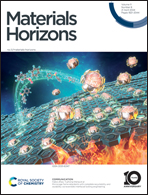Thermo-growing ion clusters enabled healing strengthening and tough adhesion for highly reliable skin electronics†
Abstract
Self-healing and self-adhesion capacities are essential for many modern applications such as skin-interfaced electronics for improving longevity and reliability. However, the self-healing efficiency and adhesive toughness of most synthetic polymers are limited to their original network, making reliability under dynamic deformation still challenging. Herein, inspired by the growth of living organisms, a highly stretchable supramolecular elastomer based on thermo-responsive ion clusters and a dynamic polysulfide backbone was developed. Attributed to the synergic growth of ion clusters and dynamic exchange of disulfide bonds, the elastomer exhibited unique healing strengthening (healing efficiency >200%) and thermo-enhanced tough adhesion (interfacial toughness >500 J m−2) performances. To prove its practical application in highly reliable skin electronics, we further composited the elastomer with a zwitterion to prepare a highly conductive ionic elastomer and applied it in wearable strain sensing and long-term electrophysiological detection. This work provides a new avenue to realize high reliability in skin interfaced electronics.

- This article is part of the themed collection: #MyFirstMH


 Please wait while we load your content...
Please wait while we load your content...